The Health Education Assets Library (HEAL) is a collection of over 22,000 freely available digital materials for health sciences education. The collection is now housed at the University of Utah J. Willard Marriott Digital Library.
TO
Filters: Collection: ehsl_heal
| Title | Description | Subject | Collection | ||
|---|---|---|---|---|---|
| 101 |
 |
Elastin in alveolar tip in lung tissue (human, adult) | Immuno-electron microscopy (embedded in Lowicryl HM 20). The amorph elastin (E) appears pale after embedding in this type of resin, but is antibody-labeled with electron-dense gold particles of 10 nm. (Col) indicate bundles of collagen fibers which are intermingled with swollen cytoplasmic extension... | Alveolar cell type I; Myofibroblast; Immuno-electron microscopy; Immuno-staining | Poja Histology Collection - Respiratory System Subset |
| 102 |
 |
Elastin in alveolus of lung tissue (human, adult) | Immuno-electron microscopy (embedded in Lowicryl HM 20). Elastin (E) is labeled with electron-dense gold particles of 10 nm. Note that the amorph elastin appears pale after embedding in this type of resin. (A) indicates alveolar space, (F) unlabelled myofibrolast, (C) collagen fibers, and (1) the th... | Alveolar cells type I; Myofibroblasts; Immuno-electron microscopy; Immuno-staining | Poja Histology Collection - Respiratory System Subset |
| 103 |
 |
Elastin in alveolus of lung tissue (human, adult) | Immuno-electron microscopy (embedded in Lowicryl HM 20). The amorph elastin (E) appears pale after embedding in this type of resin, but is antibody-labeled with electron-dense gold particles of 10 nm. (C) indicate bundles of collagen fibers (unlabeled) which are intermingled with swollen cytoplasmic... | Immuno-staining; Immuno-electron microscopy | Poja Histology Collection - Respiratory System Subset |
| 104 |
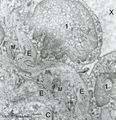 |
Elastin in lung arteriole (human, adult) | Immuno-electron microscopy (embedded in Lowicryl HM 20). The alveolar septa contain a muscular pulmonary arteriole (lumen = X) with unlabelled endothelial cells (1). The elastic membranes in the arteriolar walls consist of more or less continuous bands of amorphous elastic lumps (E) antibody-labeled... | Alveolar septum; Immuno-electron microscopy; Immuno-staining | Poja Histology Collection - Respiratory System Subset |
| 105 |
 |
Enamel (odontogenic) organ in tooth development - bell stage, human, embryo | Stain: Azan. Outer surface of bell; from left to right: (avascular) Stellate reticulum; capillaries in this stage proliferate and invaginate between the outer dental epithelial cells; Part of fibrous tooth follicle. | oral cavity | Poja Histology Collection - Oral Cavity Subset |
| 106 |
 |
Enamel in longitudinal section of tooth - human, adult. Thin ground section, polarizing microscopy - optical axes of the polarizing plates are crossed at 60. | Using polarizing microscopy the birefringence of the crystalline structure of enamel is colorful demonstrated. Incremental lines (striae) of Retzius are well shown as straight oblique zones. Note the parallel lines of enamel stacks at the left corner of the picture. At the right side the lightly col... | oral cavity; Retzius; dentinoenamel junction | Poja Histology Collection - Oral Cavity Subset |
| 107 |
 |
Enamel in longitudinal section of tooth - human, adult. Thin ground section, polarizing microscopy - optical axes of the polarizing plates are crossed at 60. | Using polarizing microscopy the birefringence of the crystalline structure of enamel is colorful demonstrated. Incremental lines (striae) of Retzius are well shown as straight oblique zones. Top right a long dark fissure-like structure representing a crack. | oral cavity; Retzius; dentinoenamel junction | Poja Histology Collection - Oral Cavity Subset |
| 108 |
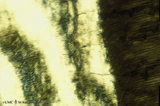 |
Enamel in longitudinal section of tooth - human, adult. Thin ground section, polarizing microscopy - optical axes of the polarizing plates are crossed at 60. | Left side enamel and at right side dark-stained striation of dentin. Wavy course of enamel prisms from dentinoenamel junction (right side, scalloped appearance) to the left. The transparent areas represent enamel lanes at a different polarizing angle. | oral cavity; dentinoenamel junction | Poja Histology Collection - Oral Cavity Subset |
| 109 |
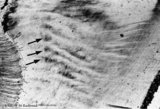 |
Enamel in longitudinal section of tooth - human, adult. Thin ground section. | From left to right: dentin with dentinal tubules; dentinoenamel junction; enamel with arrows pointing to bands (lines) of Hunter-Schreger; these alternating light and dark strips originate at the dentinoenamel junction and do not reach the enamel surface. This optical phenomenon is the result of the... | oral cavity; Hunter-Schreger bands; Retzius | Poja Histology Collection - Oral Cavity Subset |
| 110 |
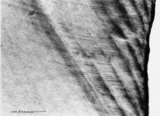 |
Enamel in longitudinal section of tooth - human, adult. Thin ground section. | From left to right: incremental lines (striae) of Retzius are distinctly shown as oblique broad zones (at the left) to the enamel surface; during formation of the crown successive apposition of layers of enamel is deposited and results in these so-called incremental grow lines; surface of enamel in ... | oral cavity; incremental lines; Retzius | Poja Histology Collection - Oral Cavity Subset |
| 111 |
 |
Enamel in longitudinal section of tooth - human, adult. Thin ground section. | At the left side surface of enamel in cuspal region; the parallel horizontal arrangement of stacks of rods (prisms) is evident. At the right side area of dentin (dark area). Incremental lines (striae) of Retzius run as curved lines (from bottom to middle top) and presented successive apposition of l... | oral cavity; incremental lines; Retzius; Hunter-Schreger bands | Poja Histology Collection - Oral Cavity Subset |
| 112 |
 |
Enamel in longitudinal section of tooth - human, adult. Thin ground section. | Enamel is compact and acellular, and consists of vertical stacks of rods (prisms) as well as interrod (interprismatic) regions with less calcifying substance parallel to each other. Each prism is surrounded by an enamel sheath (a non-mineralized organic substance). From left to right: surface of ... | oral cavity; enamel rods; enamel prisms | Poja Histology Collection - Oral Cavity Subset |
| 113 |
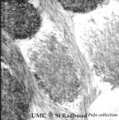 |
Enamel rods (prisms) in tooth development - gerbil, postnatal | Electronmicroscopy. Cross-section of rods (prisms) demonstrate round aggregates with hydroxyapatite crystals. Between the round rods the interprismatic substance with crystals orientated in a different course. Note that twisting of the crystallites can be seen in the longitudinal bundles where grey ... | oral cavity; enamel prisms; hydroxyapatite crystals | Poja Histology Collection - Oral Cavity Subset |
| 114 |
 |
Epiglottis (human) | Stain: Hematoxylin and eosin. Stratified squamous epithelium (1) at the laryngeal side (top). Lymphocyte accumulation (2) in the lamina propria. Below elastic cartilage (3) and seromucous laryngeal glands (4) with draining ducts. | Squamous epithelium; Laryngeal glands | Poja Histology Collection - Respiratory System Subset |
| 115 |
 |
Epithelial lining of bronchiolus in the lung (mammalia) | Scheme electron microscopy. Two major cell types line a bronchiolus, a more cuboidal shaped ciliated one (1) that also exhibits microvilli with many organelles (including electron-dense lysosomal structures). The non-ciliated cells (2, Clara cells) appeared taller and dome-shaped and protrude into t... | Bronchiolus; Ciliated epithelium; Clara cells | Poja Histology Collection - Respiratory System Subset |
| 116 |
 |
Epithelial lining of bronchiolus in the lung (rat) | Scanning electron microscopy. Bushes of cilia indicate the presence of ciliated cells (1). Clustered non-ciliated cells (2, Clara cells) are dome-shaped with stubby microvilli at the surface, they protrude into the lumen to the tips of the cilia. | Bronchiolus ; Ciliated epithelium ; Clara cells | Poja Histology Collection - Respiratory System Subset |
| 117 |
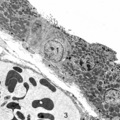 |
Epithelial lining of respiratory bronchiolus in the lung (gerbil) | Electron microscopy (low magnification). Two major cell types line a bronchiolus: a cuboidal-shaped ciliated one that exhibits microvilli with many organelles (1); the non-ciliated cells (2, Clara cells) are taller and are well provided with numerous electron-grey and smaller electron-dense secretor... | Respiratory bronchiolus; Ciliated epithelium; Cuboidal epithelium; Clara cells; Secretory granules | Poja Histology Collection - Respiratory System Subset |
| 118 |
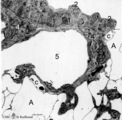 |
Epithelial lining of respiratory bronchiolus in the lung (rat) | Electron microscopy (low magnification). The epithelial lining of the respiratory bronchiolus contains ciliated cells (1) and Clara cells (2) with electron-dense secretory granules. At (4) interstitium with elastin, collagen and myofibroblasts; (5) shows a small pulmonary arteriole. At arrow (→) a... | Respiratory bronchiolus; Ciliated epithelium; Clara cells; Secretory granules; Pneumocytes; Alveolar cells; Interstitium | Poja Histology Collection - Respiratory System Subset |
| 119 |
 |
Epithelial lining of terminal bronchiolus (golden hamster) | Electron microscopy (low magnification). Two major epithelial cell types line the bronchiolus: (1) the ciliated cells with many organelles, and (2) the non-ciliated cells or Clara cells well provided with organelles, especially agranular endoplasmic reticulum and depending on their activity, numerou... | Terminal bronchiolus; Ciliated epithelium ; Clara cells; Neuro-endocrine cells; Pneumocytes; Alveolar cell types; Interstitium | Poja Histology Collection - Respiratory System Subset |
| 120 |
 |
Epithelial lining of trachea and bronchiolus (mammals) | Left side trachea: Columnar ciliated cells (1) with up to 200 motile cilia with an organelle-rich apex and in the middle a goblet cell (2) with accumulation of mucus secretion granules in the apex. Note that all epithelial cells (i.e., junctions) contact the basal lamina. Four basal cells (3) do not... | Bronchiolus; Pseudostratified epithelium; Ciliated epithelium; Clara cells; Basal cells; Neuro-endocrine cells | Poja Histology Collection - Respiratory System Subset |
| 121 |
 |
Epithelial tooth bud in tooth development - tooth germ, human, embryo | Stain: hematoxylin. At the top stratified ectoderm. The proliferating basal cell layers are palisade-arranged with a light cytoplasm close to the basement membrane (right side). Below the basement membrane subepithelially an accumulation of inductive neural crest-derived mesenchymal cells is locally... | oral cavity; tooth bud; tooth development | Poja Histology Collection - Oral Cavity Subset |
| 122 |
 |
Epithelium of respiratory bronchiolus (detail, human, high magnification) | Stain: Azan. An irregular lining of low columnar-cuboidal cells (1) and thin alveolar epithelium (2) are present. Note cuboidal Clara cells (↓). At (3) small patches of smooth muscles and at (4) macrophages with phagocytized carbon particles (black dots). Small pulmonary artery (5), lymph capillar... | Respiratory bronchiolus; Cuboidal epithelium; Alveolar epithelium; Lymph capillary | Poja Histology Collection - Respiratory System Subset |
| 123 |
 |
Epithelium of trachea (golden hamster) | Electron microscopy. Columnar ciliated cells (1) with cilia and organelle-rich apex; a goblet cell (2a) with accumulation of mucous secretion granules supranuclearly. Another goblet cell (2b) appears deprived; one basal cell (3) does not extend to the free surface. Light-grey aggregations of elastin... | Respiratory epithelium ; Pseudostratified epithelium; Basal cells | Poja Histology Collection - Respiratory System Subset |
| 124 |
 |
Epithelium of trachea (mammals, common respiratory epithelium) | Scheme electron microscopy. Columnar ciliated cells (1) with up to 200 motile cilia with an organelle-rich apex and in the middle a goblet cell (2) with accumulation of mucus secretion granules in the apex. Note that all epithelial cells (i.e., junctions) contact the basal lamina. Four basal cells (... | Respiratory epithelium ; Pseudostratified epithelium; Basal cells | Poja Histology Collection - Respiratory System Subset |
| 125 |
 |
Exocrine gland (salivary gland) | Scheme electronmicroscopy. Part of an acinus of mucous cells with different amount of mucous secretion. Supranuclearly the Golgi areas with maturing mucous secretion granules, basolateral the endoplasmic reticulum. At the top the lumen. The left cell shows an accumulation of the secretory droplets, ... | oral cavity; mucous gland | Poja Histology Collection - Oral Cavity Subset |
